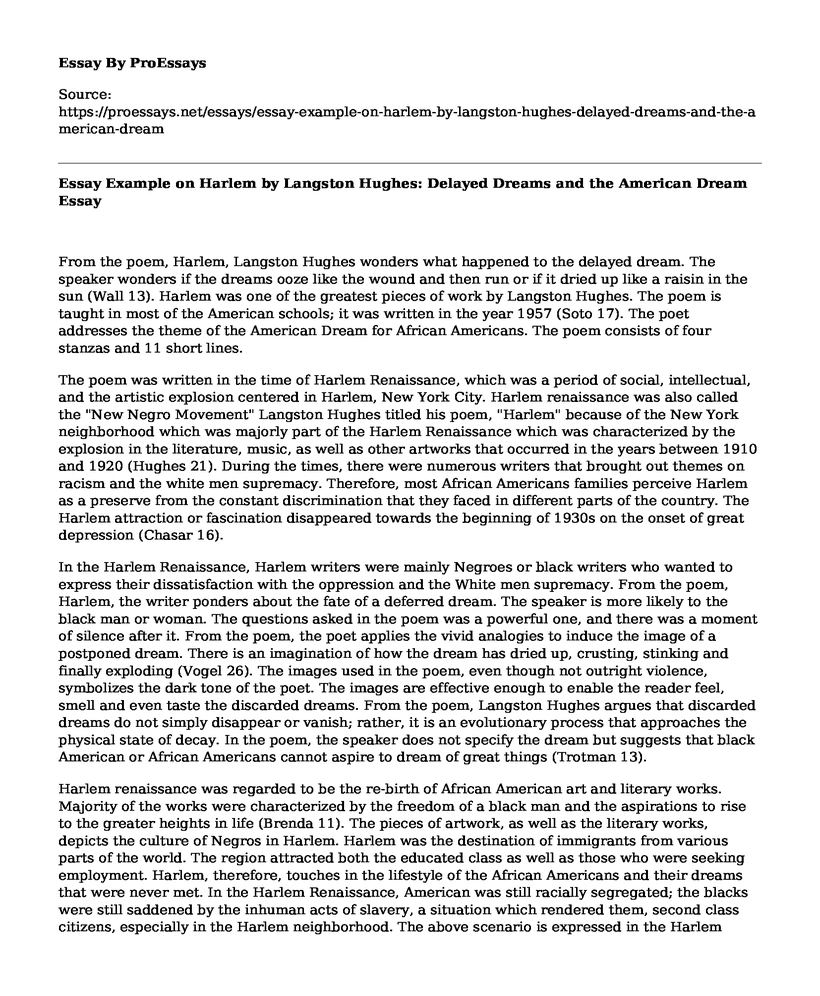From the poem, Harlem, Langston Hughes wonders what happened to the delayed dream. The speaker wonders if the dreams ooze like the wound and then run or if it dried up like a raisin in the sun (Wall 13). Harlem was one of the greatest pieces of work by Langston Hughes. The poem is taught in most of the American schools; it was written in the year 1957 (Soto 17). The poet addresses the theme of the American Dream for African Americans. The poem consists of four stanzas and 11 short lines.
The poem was written in the time of Harlem Renaissance, which was a period of social, intellectual, and the artistic explosion centered in Harlem, New York City. Harlem renaissance was also called the "New Negro Movement" Langston Hughes titled his poem, "Harlem" because of the New York neighborhood which was majorly part of the Harlem Renaissance which was characterized by the explosion in the literature, music, as well as other artworks that occurred in the years between 1910 and 1920 (Hughes 21). During the times, there were numerous writers that brought out themes on racism and the white men supremacy. Therefore, most African Americans families perceive Harlem as a preserve from the constant discrimination that they faced in different parts of the country. The Harlem attraction or fascination disappeared towards the beginning of 1930s on the onset of great depression (Chasar 16).
In the Harlem Renaissance, Harlem writers were mainly Negroes or black writers who wanted to express their dissatisfaction with the oppression and the White men supremacy. From the poem, Harlem, the writer ponders about the fate of a deferred dream. The speaker is more likely to the black man or woman. The questions asked in the poem was a powerful one, and there was a moment of silence after it. From the poem, the poet applies the vivid analogies to induce the image of a postponed dream. There is an imagination of how the dream has dried up, crusting, stinking and finally exploding (Vogel 26). The images used in the poem, even though not outright violence, symbolizes the dark tone of the poet. The images are effective enough to enable the reader feel, smell and even taste the discarded dreams. From the poem, Langston Hughes argues that discarded dreams do not simply disappear or vanish; rather, it is an evolutionary process that approaches the physical state of decay. In the poem, the speaker does not specify the dream but suggests that black American or African Americans cannot aspire to dream of great things (Trotman 13).
Harlem renaissance was regarded to be the re-birth of African American art and literary works. Majority of the works were characterized by the freedom of a black man and the aspirations to rise to the greater heights in life (Brenda 11). The pieces of artwork, as well as the literary works, depicts the culture of Negros in Harlem. Harlem was the destination of immigrants from various parts of the world. The region attracted both the educated class as well as those who were seeking employment. Harlem, therefore, touches in the lifestyle of the African Americans and their dreams that were never met. In the Harlem Renaissance, American was still racially segregated; the blacks were still saddened by the inhuman acts of slavery, a situation which rendered them, second class citizens, especially in the Harlem neighborhood. The above scenario is expressed in the Harlem poem.
Works Cited
Brenda Haugen,. Langston Hughes: The Voice of Harlem. Capstone, 2006.
Chasar, Mike. "The Sounds of Black Laughter and the Harlem Renaissance: Claude McKay, Sterling Brown, Langston Hughes." American Literature 80.1 (2008): 57-81.
Hughes, Langston. Selected Poems of Langston Hughes. Vintage, 2011.
Soto, Michael, ed. Teaching the Harlem Renaissance: course design and classroom strategies. Vol. 16. Peter Lang, 2008.
Trotman, C. James. Langston Hughes: the man, his art, and his continuing influence. Routledge, 2014.
Vogel, Shane. The scene of Harlem cabaret: Race, sexuality, performance. University of Chicago Press, 2009.
Wall, Cheryl A. The Harlem Renaissance: A Very Short Introduction. Vol. 479. Oxford University Press, 2016.
Cite this page
Essay Example on Harlem by Langston Hughes: Delayed Dreams and the American Dream. (2023, Feb 20). Retrieved from https://proessays.net/essays/essay-example-on-harlem-by-langston-hughes-delayed-dreams-and-the-american-dream
If you are the original author of this essay and no longer wish to have it published on the ProEssays website, please click below to request its removal:
- A Literary Essay Example: Chivalric Ideals Pursued by Don Quixote
- Ethics and Human Resources Management Paper Example
- Brighton Beach Memoirs Essay Example
- Literary Analysis Essay on 'The Trial' by Franz Kafka and 'The Plague' by Albert Camus
- Ultimate Questions of Life
- Paper Example on John Conrad: From Congo to Victorian Scholar
- Essay Example on Are Humans Naturally Good or Bad?







